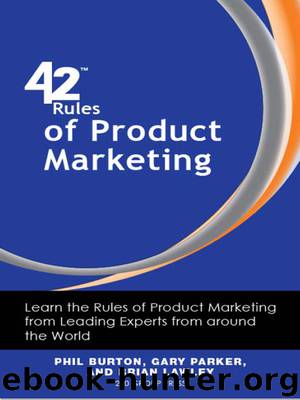42 Rules of Product Marketing by Phil Burton

Author:Phil Burton
Language: eng
Format: epub
Publisher: Super Star Press
My company used this research to create a powerful curriculum planning application to complement its science lessons. The teacher loaded the program on their computer and would check the national science standards that he or she wanted to cover in class. The application then assembled an entire lesson plan to match.
The company was very excited about this new teacher support application that complemented a well-designed science program. The company announced the new application with great pride at a small, education conference and trade show. The marketing materials prominently advertised that this science program, “Saved teachers time.” It flopped! Reception to the announcement and the product was lukewarm. Something was wrong. Yet all the research said that, “Not having enough time in the day,” was a major pain point for educators.
Not able to reconcile this point, I embarked on another round of interviews, this time to review the company’s marketing. I gained great insight into our messaging with just a handful of discussions with elementary school educators. First, the message has to match where the customer is in the buying cycle. When considering a new program, the initial question for the teacher is whether the lesson as designed by the publisher will interest her students. Only if she believes the students will be interested, does she ask the second question: “Will I be able to implement this curriculum successfully in the classroom?”
Second, I learned that teachers found the marketing materials offensive. By promoting the main benefit of the program as being timesav-ing, teachers felt the company was suggesting that they were looking to take shortcuts. Therefore, not only was the company’s marketing focused on the wrong message in the buying cycle, it also offended the very audience we were looking to persuade.
As a result, we changed the main message to “engaging students in science” which went to the heart of the primary buying motivation. We then focused the secondary message on ease of implementation, which conveyed a similar idea as timesaving without offending. The national level education tradeshow that followed the messaging change was a great success.
Fortunately for the company, the messaging error was picked up and corrected early. Nevertheless, I learned some valuable lessons, the most important being to test your marketing message with real customers. With the Internet, testing messaging is now easier than when I learned this lesson. For example, I can test the click through rates of different Google Adwords campaigns and the effectiveness of different landing pages without ever getting up from my desk. Nevertheless, even with this convenience, I still have to speak to customers to understand why one message works better than another does. Before I launch a product now, I always first test my message.
Download
This site does not store any files on its server. We only index and link to content provided by other sites. Please contact the content providers to delete copyright contents if any and email us, we'll remove relevant links or contents immediately.
Influence: The Psychology of Persuasion by Robert B. Cialdini(4599)
The Miracle Morning by Hal Elrod(4422)
The Hacking of the American Mind by Robert H. Lustig(4082)
Pre-Suasion: A Revolutionary Way to Influence and Persuade by Robert Cialdini(3975)
Unlabel: Selling You Without Selling Out by Marc Ecko(3467)
Ogilvy on Advertising by David Ogilvy(3327)
Hidden Persuasion: 33 psychological influence techniques in advertising by Marc Andrews & Matthijs van Leeuwen & Rick van Baaren(3292)
Purple Cow by Seth Godin(3069)
Who Can You Trust? by Rachel Botsman(3024)
Kick Ass in College: Highest Rated "How to Study in College" Book | 77 Ninja Study Skills Tips and Career Strategies | Motivational for College Students: A Guerrilla Guide to College Success by Fox Gunnar(2997)
This Is Marketing by Seth Godin(2901)
I Live in the Future & Here's How It Works by Nick Bilton(2844)
The Marketing Plan Handbook: Develop Big-Picture Marketing Plans for Pennies on the Dollar by Robert W. Bly(2792)
The Power of Broke by Daymond John(2770)
Building a StoryBrand by Donald Miller(2754)
The 46 Rules of Genius: An Innovator's Guide to Creativity (Voices That Matter) by Marty Neumeier(2678)
Draw to Win: A Crash Course on How to Lead, Sell, and Innovate With Your Visual Mind by Dan Roam(2639)
The Tipping Point by Malcolm Gladwell(2554)
Market Wizards by Jack D. Schwager(2538)
